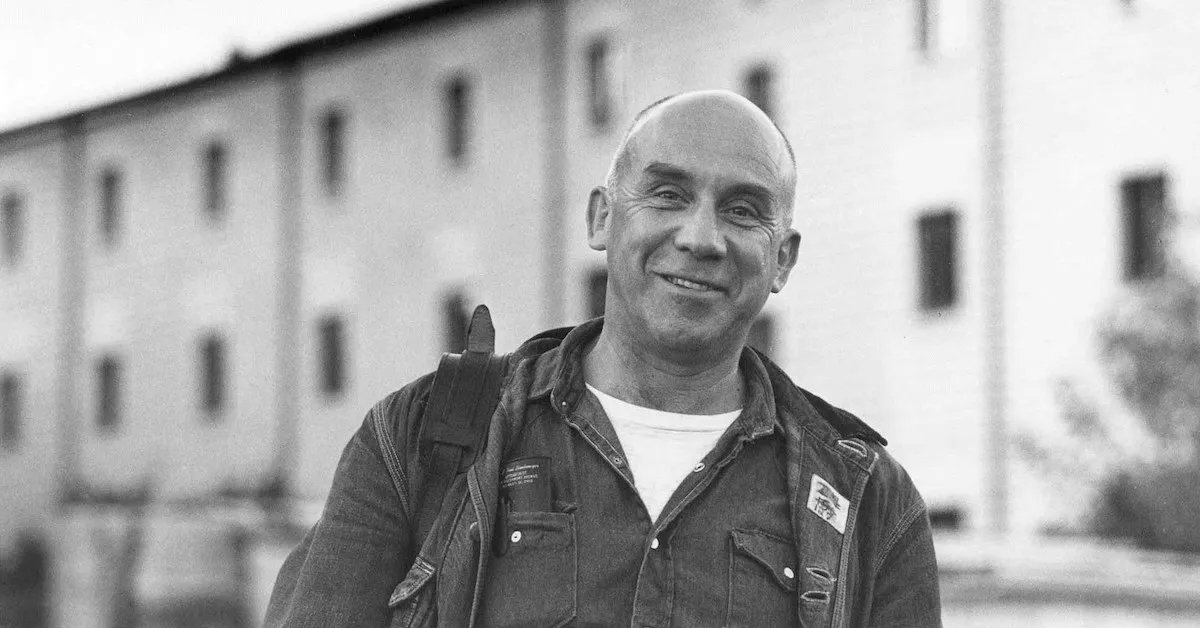
“The Bible — a Two Edged Sword” by Keith Basar
The centrality of Scripture (at least from the Protestant perspective) is surely a double edged sword. Hey, it’s God’s word! Isn’t this what us Protestants were taught? The final authority, sola scriptura. Actually, if we pry a little deeper, that notion of “Gods Word” (the Bible) is suspect.

Feeling Left Behind by Age? These 5 Buddhist Truths Will Change Everything
A WISE OLD MONK LIVED IN A REMOTE MOUNTAIN TEMPLE.
KNOWN TO VILLAGERS FOR HIS KINDNESS AND WISDOM
OVER THE DECADES MANY SOUGHT HIS ADVICE
AND HE GUIDED THEM THROUGH THEIR STRUGGLES.
ONE DAY A YOUNG DISCIPLE ASKED MASTER,
“DOES IT NOT SADDEN YOU THAT WHEN YOU PASS AWAY
PEOPLE MAY FORGET YOUR NAME?”

The Illusion of Our False Self by James Finley (second piece is – “Thomas Merton, abridged and adapted from “New Seeds of Contemplation“)
Guest writer and CAC faculty member James Finley continues exploring insights on the true self and false self that he gleaned from Thomas Merton.
In the following text, Merton makes clear that the self-proclaimed autonomy of the false self is but an illusion:
Every one of us is shadowed by an illusory person: a false self.
This is the man I want myself to be but who cannot exist, because God does not know anything about him. And to be unknown of God is altogether too much privacy.

“The Wandering Taoist” — story by Solala Towler (transcript from YouTube)
The cold wind blowing off the western desert ruffled the beard of the old man riding slowly atop the water buffalo. It whipped around his traveling cloak and made him shiver deep within his robes. He tried wrapping the cloak a little tighter around his shoulders but it did him little good. It was a bad time of the year for traveling, but that could not be helped. The stolid beast plodded on slowly toward the frontier.
A horse would have been faster, but this beast was steadier, more surefooted in the mountains and ate very little. He supposed it was a bit of reverse vanity that prompted him to travel on so humble a mount, the last vestige of the once proud royal archivist.
SUPPORT THE GOOD WORK OF SOLALA TOWLER

“God’s Violence in the Old Testament, (part 2) Possible Solutions” by Adam Hamilton
How do we resolve the moral and theological dilemmas that confront us in these Old Testament texts? As I see it, there are two broad paths forward.
The first—and the only option as I see it, for those who hold to verbal, plenary inspiration—is to accept that these commands and stories accurately capture what God said, what God did, and what God commanded his people to do. Then the task is to explain how the character of God revealed in these seemingly harsh and violent texts is consistent with the character of God revealed by Jesus Christ.

Was Jesus Feminine? by Jordan Gandhi
In the long history of Christian thought, there have been (if not frequent, at least notable) writers who emphasized the feminine side of God. Philip Sheldrake writes that “in premodern theology, motherhood and fatherhood were understood as gendered social roles of care and responsibility. For early Christians such as Clement of Alexandria (third century) and Gregory of Nyssa (fourth century), God is both a powerful father and a tender and nurturing mother” (The New Westminster Dictionary of Christian Spirituality, 449).

LOVER AND BELOVED: Mystical Love in Sufism (excerpt) by Llewellyn Vaughan-Lee
Sufism is a mystical path of love. The Sufi is a traveler on the path of love, a wayfarer journeying back to God through the mysteries of the heart. For the Sufi the relationship to God is that of lover and Beloved, and Sufis are also known as lovers of God.

Have We Misread the Bible? by By Steve Chalke
...There’s an erosion of confidence in the authority of the Bible in our society, which Dawkins’ words tap into. It is reaching critical levels, not just among those beyond the Church, but also for many within it. I have lots of conversations with Christians ? young and old ? who, from different starting points, all want to talk about the same problem: their struggle with the text of the Bible...

Lost in Translation - The Problems With Sola Scriptura by The Hidden Orchard Project
For some, Sola Scriptura is a cause for celebration, but for others, this doctrine paved the way for some significant problems down the road. How is this doctrine different from the native worldview of Jesus and the Apostolic community?

“The Soul of Education” by Thomas Moore
In our day, most people seem to think of education as stuffing the mind with facts and training the body with skills. Brain and hands. The purpose is to prepare a person to find a good job and make a good living. But the result is that we have a population that can do specialized work but doesn’t reflect on the bigger picture—the nature of things, how to become a person, how to love and relate, how to be in community, where to find meaning, and how to bring up children. The human side of learning is generally left to experience and unconscious experimentation.
BE A SUPPORTER OF THOMAS MOORES PROFOUND WORK

Meister Eckhart, Part I & 2: God’s Participation in Creation (Center for Action and Contemplation)
Meister Eckhart (1260-1327), a German friar, priest, mystic, and renowned preacher, was also an administrator—prior, vicar, and provincial—for several Dominican houses. My fellow Living School faculty member, James Finley, suggests this engagement in the “ways of the world” makes his teachings more accessible to us all: “They do not require that we lives as a hermit or go into the silence of the cloister in order to open ourselves to the experience of God’s oneness with us.” [1] Busy people can be mystics.

Neil Douglas-Klotz on The Aramaic Jesus by Tami Simon
Tami Simon: You’re listening to Insights at the Edge. Today my guest is Neil Douglas-Klotz. Neil is a world-renowned scholar in religious studies, spirituality, and psychology. He holds a PhD in religious studies and psychology from the Union Institute and taught these subjects for 10 years at Holy Names College in California. Living now in Edinburgh, Scotland, Neil Douglas-Klotz directs the Edinburgh Institute for Advanced Learning. He’s the author of several books including Prayers of the Cosmos, The Hidden Gospel, The Genesis Meditations, and The Sufi Book of Life. With Sounds True, Neil has published three audio-learning courses including the new program, I Am: The Secret Teaching of the Aramaic Jesus. Neil has also written the Sounds True book, Blessings of the Cosmos—which includes a corresponding CD of 20 guided Aramaic body prayers—where he presents a collection of all new translations of Jesus’ best-loved benedictions and invocations for peace, healing, and divine connection.
Tami Simon: You’re listening to Insights at the Edge. Today my guest is Neil Douglas-Klotz. Neil is a world-renowned scholar in religious studies, spirituality, and psychology. He holds a PhD in religious studies and psychology from the Union Institute and taught these subjects for 10 years at Holy Names College in California. Living now in Edinburgh, Scotland, Neil Douglas-Klotz directs the Edinburgh Institute for Advanced Learning. He’s the author of several books including Prayers of the Cosmos, The Hidden Gospel, The Genesis Meditations, and The Sufi Book of Life. With Sounds True, Neil has published three audio-learning courses including the new program, I Am: The Secret Teaching of the Aramaic Jesus. Neil has also written the Sounds True book, Blessings of the Cosmos—which includes a corresponding CD of 20 guided Aramaic body prayers—where he presents a collection of all new translations of Jesus’ best-loved benedictions and invocations for peace, healing, and divine connection.

Longing for the Beloved by Mirabai Starr
There is a longing that burns at the root of spiritual practice. This is the fire that fuels your journey. The romantic suffering you pretend to have grown out of, that remains coiled like a serpent beneath the veneer of maturity.
![The World's Most Dangerous Book [Part 3] by Alan Watts](https://images.squarespace-cdn.com/content/v1/5ff86e38dd4cdc650b26083e/1611241838169-4LYB5IQWY64HTV8OXA9X/Bible+5.jpg)
The World's Most Dangerous Book [Part 3] by Alan Watts
[Part 3]
Likewise, the Second Person of the Trinity, God the Son, the Logos-Sopia, refers to the basic pattern or design of the Universe, ever emerging from the inconceivable mystery or the Father as the galaxies shine out of space. This is how the great philosophers of the Church have thought about the imagery of the Bible and as it appears to a modern student of the history and psychology of world religions. Call it intellectual snobbery if you will, but although the books of the Bible might have been "plain words for plain people" in the days of Isaiah and Jesus, an uneducated and uninformed person who reads them today, and takes them as the literal Word of God, will become a blind and confused bigot.
PLEASE SUPPORT MARK WATTS PROJECT
![The World's Most Dangerous Book [Part 2] by Alan Watts](https://images.squarespace-cdn.com/content/v1/5ff86e38dd4cdc650b26083e/1611241878011-QZWPIKMQUTHQ2T1R8T5S/Bible+5.jpg)
The World's Most Dangerous Book [Part 2] by Alan Watts
[Part 2 of 3]
Such monarchs are, of course, frightened of their subjects and constantly on the anxious alert for rebellion. Is this an appropriate image for the inconceivable energy that underlies the universe? True, the altar-throne in Catholic churches is occupied by the image of God in the form of one crucified as a common thief, but he hangs there as our leader in subjection to the Almighty Father, King of the universe, propitiating Him for those who have broken His not always reasonable laws. And what of the curious resemblance between Protestant churches and courts of law? The minister and the judge wear the same black robe and "throw the book" at those assembled in pews and various kinds of boxes, and both ministers and judges have chairs of estate that are still, in effect, thrones.
![The World's Most Dangerous Book [Part 1] by Alan Watts](https://images.squarespace-cdn.com/content/v1/5ff86e38dd4cdc650b26083e/1611240893995-YOY17LZIIQ5X8L7WTC09/Bible+5.jpg)
The World's Most Dangerous Book [Part 1] by Alan Watts
The Catholic hierarchy included subtle theologians and scholars who knew very well that such a difficult and diverse collection of ancient writings, taken as the literal Word of God, would be wildly and dangerously interpreted if put into the hands of ignorant and uneducated peasants. Likewise, when a missionary boasted to George Bernard Shaw of the numerous converts he had made, Shaw asked, " Can these people use rifles?" "Oh, indeed, yes," said the missionary. "Some of them are very good shots." Whereupon Shaw scolded him for putting us all in peril in the day when those converts waged holy war against us for not following the Bible in the literal sense they gave to it. For the Bible says, "What a good thing it is when the Lord putteth into the hands of the righteous invincible might." But today, especially in the United States, there is a taboo against admitting that there are enormous numbers of stupid and ignorant people, in the bookish and literal sense of these words. They may be highly intelligent in the arts of farming, manufacture, engineering and finance, and even in physics, chemistry or medicine. But this intelligence does not automatically flow over to the fields of history, archaeology, linguistics, theology, philosophy and mythology which are what one needs to know in order to make any sense out such archaic literature as the books of the Bible.
PLEASE SUPPORT THE ALAN WATTS PROJECT

Orthodox Problems with Penal Substitution by Alexander Renault (from his book “Reconsidering Tulip” )
The penal substitution view was completely absent from the church for over 1,000 years. It was only in the 11th century that Anselm of Canterbury began to introduce the groundwork for this kind of theology to the West. Nor was it fully developed into the doctrine we now know as penal substitution until the 16th-century Reformers came along. To this day it has never been accepted in the east (nor has it ever been fully accepted by the Roman Catholics).

“Unwrathing God” with Brad Jersak — The Canadian Orthodox
It would have been so helpful to learn aspects of the Divine — minus any anthropomorphic trappings. Sadly, the consequence becomes a god made in our own image, reinforced through the lens of a literal reading of the Bible.

Doug King - “Spiral Dynamics, Deconstruction and the Future of Faith”- Presented by NOMAD PODCAST
From the Nomad Podcast Crew: We speak with Doug King about the evolution of his faith, progressing from Christian fundamentalism to a post-Christian identity. At the heart of Doug’s understanding of this journey is the historical framework of Spiral Dynamics, a model that illuminates the evolution of worldviews across cultures worldwide. This model reveals that the journey many of us have been on - from fundamentalism, through deconstruction, to a more expansive, inclusive spirituality - are not isolated personal experiences, but an integral part of the collective evolution of the human race.

The Myth of Redemptive Violence by Richard Rohr
Leviticus 16 describes the ingenious ritual from which our word “scapegoating” originated. On the Day of Atonement, a priest laid hands on an “escaping” goat, placing all the sins of the Jewish people from the previous year onto the animal. Then the goat was beaten with reeds and thorns and driven out into the desert.

